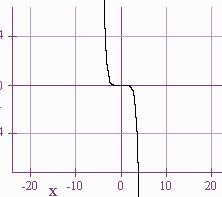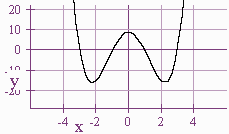Polynomials and Graphs
-
Left and Right Behavior
We will investigate the outer shape of several polynomials and explore the following rules:
Even Odd Pos UU DU Neg DD UD
Where Even and Odd refers to the degree of the polynomial, Pos and Neg refers to the leading coefficient, And a U or a D refers to the left and right behavior of the curve.Example

-3x7 + 4x4 - 1
has degree 7 which is odd and has leading coefficient -3 which is negative. Hence the left and right behavior is UD, i.e. the curve goes up on the left and down on the right.
-
Max and Min
Theorem
If f(x) is a polynomial of degree n then f(x) has at most n - 1 relative extrema. Where relative extrema are lumps of the graph.
Example:4x5 + 2x3 - x2 + 7x + 12
Has at most 4 relative extrema.
-
Three Step Procedure For Graphing Polynomials
Step 1: Factor the polynomial into linear factors of the form
ax + bStep 2 : Determine the left and right behavior of the graph and the shape of the graph near each x intercept.
Step 3: Connect the dots.
Example:
Graph
y = x4 - 10x2 + 9-
We have
y = (x2 -9)(x2 - 1) = (x - 3)(x + 3)(x - 1)(x + 1)
-
The left behavior is up and the right behavior is up.
Near x = -3 the graph is positive on the left and negative on the right.
Near x = -1 the graph is negative on the left and positive on the right
Near x = 1 the graph is positive on the left and negative on the right.
Near x = 3 the graph is negative on the left and positive on the right
-

-
Back to the Math Department Home
e-mail Questions and Suggestions